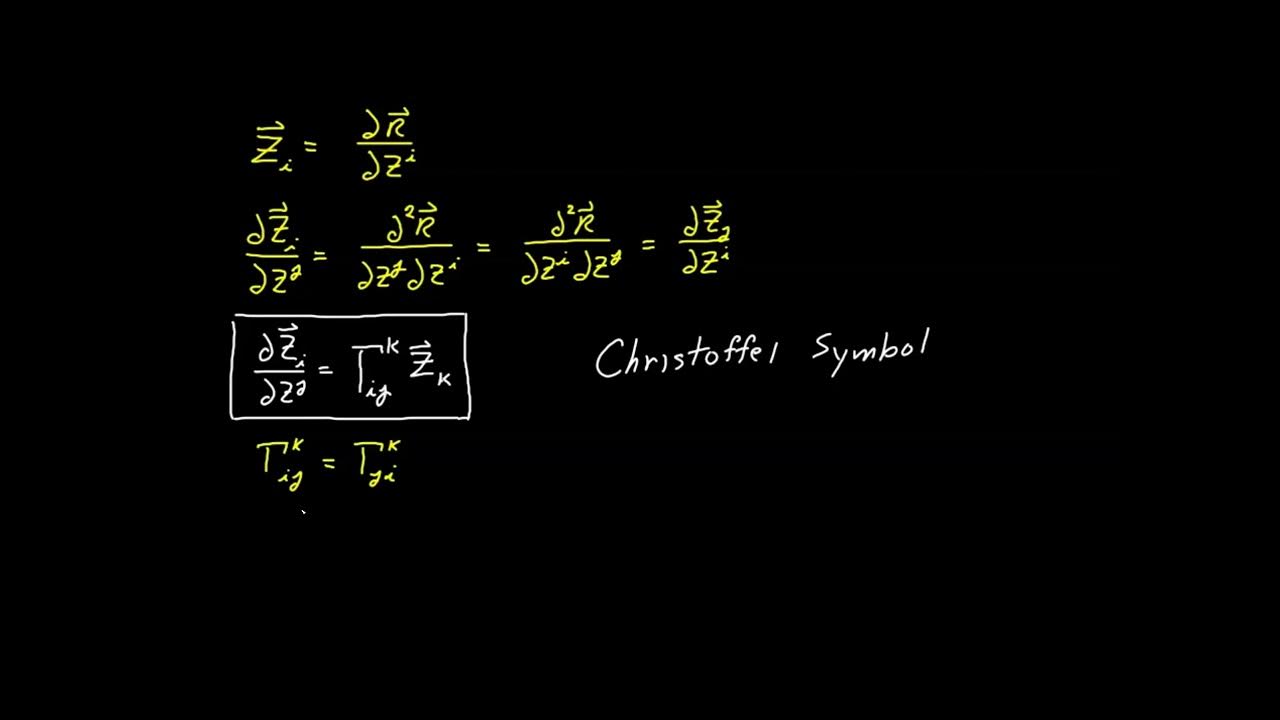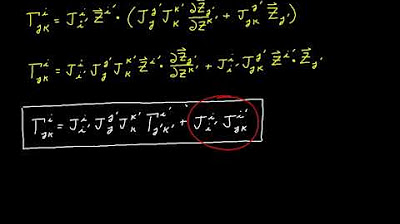Tensor Calculus Lecture 6c: The Covariant Derivative 2
TLDRThis educational script delves into the intricacies of the covariant derivative in tensor calculus, emphasizing its definition, properties, and relationship with Christoffel symbols. It clarifies that the covariant derivative of an invariant is simply the partial derivative and demonstrates the commutativity of covariant derivatives. The script also introduces the Riemann Christoffel tensor, highlighting its significance and proving its vanishing in Cartesian coordinates due to the tensor's transformation properties, offering a foundational understanding of curvature in space.
Takeaways
- 📚 The covariant derivative is defined by applying specific operations to each type of index, including terms with the Christoffel symbol for contravariant indices.
- 🔍 For tensors of order zero (invariants), the covariant derivative simplifies to just the partial derivative, as there are no additional Christoffel terms.
- 🌐 In Cartesian coordinates, the covariant derivative is equivalent to the partial derivative because the Christoffel symbols vanish, which is a defining characteristic of affine coordinate systems.
- 🔄 The covariant derivative commutes with contraction, meaning the order of applying these operations does not affect the result, which is a critical property in tensor calculus.
- 📉 The covariant derivative applied to a tensor of any order results in a new tensor, demonstrating the tensorial nature of the derivative operation.
- 🎯 The Riemann-Christoffel tensor, which describes the difference between successive covariant derivatives, is identically zero in all coordinate systems where Cartesian coordinates are possible.
- 🧩 The Riemann-Christoffel tensor is composed of products of Christoffel symbols and can be shown to vanish by considering its behavior in Cartesian coordinates.
- 📐 The metric tensor and its related quantities (like the covariant basis) behave like constants under covariant differentiation in Cartesian coordinates, simplifying calculations.
- 🤔 The script raises the question of the behavior of the Riemann-Christoffel tensor in non-Euclidean spaces, such as those with arbitrary metric tensors, which is foundational for understanding general relativity.
- 📝 The process of applying the covariant derivative, contraction, and understanding their properties is emphasized as an essential exercise for mastering tensor calculus.
- 📚 The script serves as a comprehensive review of the covariant derivative, its properties, and its implications in the context of general relativity and differential geometry.
Q & A
What is the covariant derivative and why is it important in tensor calculus?
-The covariant derivative is a way to differentiate tensors in a way that is consistent with the curvature of the space they are defined on. It is important because it generalizes the notion of a derivative to curved spaces and is essential for formulating physical laws in a coordinate-independent way.
How does the covariant derivative differ from the partial derivative?
-The covariant derivative takes into account the effects of curvature through the Christoffel symbols, which are absent in the partial derivative. While the partial derivative does not produce a tensor, the covariant derivative does, making it suitable for use in curved spaces.
What is the significance of the Christoffel symbols in the definition of the covariant derivative?
-Christoffel symbols are crucial in the definition of the covariant derivative as they encode the curvature of the space. They ensure that the derivative is a tensor and that it transforms correctly under changes of coordinates.
Why is it stated that we don't need to memorize the definition of the covariant derivative?
-The indices in the definition of the covariant derivative are not arbitrary; they follow a specific pattern that naturally places the indices in their correct positions. Understanding this pattern is more important than memorizing the exact formula.
What is the first property of the covariant derivative when applied to a tensor of order zero?
-The first property is that the covariant derivative of a tensor of order zero, such as an invariant, is simply the partial derivative. This is because there are no additional indices to introduce Christoffel terms.
In what type of coordinate system does the covariant derivative coincide with the partial derivative?
-The covariant derivative coincides with the partial derivative in Cartesian or affine coordinate systems, where the Christoffel symbols vanish, and the covariant basis is unchanged from one point to another.
What is the difference between applying the covariant derivative first and then contracting indices versus contracting first and then applying the derivative?
-The difference lies in the order of operations. However, due to the properties of the covariant derivative and the commutativity of tensor operations, both methods yield the same result, ensuring that expressions involving the covariant derivative and contraction are unambiguous.
What does the commutativity of the covariant derivative with contraction imply about the Riemann-Christoffel tensor?
-The commutativity implies that the Riemann-Christoffel tensor, which is the difference between two covariant derivatives in different orders, is identically zero in all coordinate systems where the covariant derivative is defined as equivalent to the partial derivative.
What is the significance of the Riemann-Christoffel tensor in the context of general relativity?
-The Riemann-Christoffel tensor is a fundamental object in general relativity, describing the curvature of spacetime. Its vanishing in Cartesian coordinates indicates the flatness of spacetime in such coordinate systems, which is a key concept in understanding the geometric nature of gravity.
How does the covariant derivative restore the simplicity of Cartesian coordinates while retaining the generality of curvilinear coordinates?
-The covariant derivative allows for the differentiation of tensors in a way that treats the metric tensor as if it were a constant, similar to how derivatives are taken in Cartesian coordinates. This makes the process of differentiation simpler, while still being applicable to any coordinate system, thus retaining the generality of curvilinear coordinates.
Outlines
📚 Covariant Derivative Definition and Properties
The paragraph delves into the definition of the covariant derivative, emphasizing its application to tensors of various orders. It explains that for a tensor of order zero, the covariant derivative simplifies to a partial derivative due to the absence of additional Christoffel terms. The speaker reinforces the idea that the covariant derivative of an invariant is equivalent to the partial derivative, highlighting this as property number one. The paragraph also touches on the covariant basis and its utility, and ends with a discussion about the covariant derivative in Cartesian coordinates, where it aligns with the partial derivative when Christoffel symbols vanish.
🔍 Interpreting Tensor Operations: Covariant Derivative and Contraction
This section explores the application of the covariant derivative to a third-order tensor and the subsequent contraction, offering two different interpretations. The first interpretation involves applying the covariant derivative first, resulting in additional terms and a fourth-order tensor, followed by contraction. The second interpretation suggests performing the contraction first, simplifying the tensor to an order one before applying the covariant derivative. The paragraph challenges the audience to perform these operations themselves and compare the results, aiming to demonstrate the commutativity of these operations in tensor calculus.
🤔 Understanding Tensor Calculus: Mistakes and Corrections
The speaker candidly admits to making a mistake in a tensor calculus operation, emphasizing that learning involves making and correcting errors. The paragraph focuses on the process of operating on lower indices in tensor calculus, particularly when dealing with Christoffel symbols. It discusses the importance of remembering the arrangement and sign changes when expanding terms. The speaker corrects the mistake by re-examining the operation on indices and the application of the covariant derivative, leading to a clearer understanding of tensor operations.
🔗 The Commutativity of Covariant Derivatives and Contraction
This paragraph investigates the commutativity of covariant derivatives and contractions, a fundamental property in tensor calculus. The speaker presents two interpretations of applying these operations to a tensor and demonstrates that the results are equivalent, regardless of the order in which they are applied. The paragraph reinforces the idea that the covariant derivative and contraction can be interchanged without affecting the outcome, solidifying the concept of commutativity in tensor calculus.
📘 Exploring the Metronomic and Product Rules in Tensor Calculus
The paragraph discusses additional properties of the covariant derivative, including the metronomic property, which states that the covariant derivative of the metric tensor and related objects results in zero. It also touches on the product rule, also known as the Leibniz rule, and raises a critical question about the commutation of successive covariant derivatives. The speaker sets the stage for a deeper exploration of these properties and their implications in tensor calculus.
🌐 The Commutativity of Covariant Derivatives: A Deep Dive
This section takes a deep dive into the question of whether covariant derivatives commute when applied successively to a tensor. The speaker outlines the complex expressions that arise from such operations and introduces the Riemann-Christoffel tensor, a fundamental object in differential geometry. The paragraph builds up to a profound conclusion about the nature of these operations and their implications for the study of curvature in space.
📉 The Riemann-Christoffel Tensor and Its Properties
The speaker introduces the Riemann-Christoffel tensor and discusses its properties, particularly its transformation behavior across different coordinate systems. The paragraph establishes that the Riemann-Christoffel tensor is indeed a tensor and that it vanishes identically in all coordinate systems where Cartesian coordinates are possible. The discussion leads to the conclusion that the tensor's value is consistent across systems, leveraging the tensor property and the specific behavior of covariant derivatives in Cartesian coordinates.
🌌 The Relevance of the Riemann-Christoffel Tensor in Curved Spaces
In this concluding paragraph, the speaker reflects on the implications of the Riemann-Christoffel tensor in the context of curved spaces, as opposed to the Euclidean spaces discussed earlier. The paragraph highlights that in spaces where Cartesian coordinates are not possible, such as in the presence of gravity that warps space, the Riemann-Christoffel tensor does not vanish and becomes a key element in understanding the curvature of the universe. The speaker prepares the audience for further discussions on curved surfaces and the fundamental differences in tensor behavior in such spaces.
Mindmap
Keywords
💡Covariant derivative
💡Christoffel symbols
💡Tensor
💡Invariant
💡Partial derivative
💡Curvature
💡Riemann Christoffel tensor
💡Metronomic property
💡Affine coordinates
💡Commutator
Highlights
Review of covariant derivative definition and its application to tensors of different indices.
Explanation of the covariant derivative's simplification to a partial derivative for a tensor of order zero.
Discussion on the covariant derivative's equivalence to partial derivatives in Cartesian coordinates due to vanishing Christoffel symbols.
Illustration of the covariant derivative's application to the position vector, emphasizing its utility in tensor calculus.
Demonstration of the covariant derivative's commutation with contraction, showing its non-ambiguity in tensor operations.
Introduction of the Riemann Christoffel tensor and its foundational role in understanding the curvature of space.
Analysis of the Riemann Christoffel tensor's expression in terms of partial derivatives and Christoffel symbols.
Proof that the Riemann Christoffel tensor is identically zero in Cartesian coordinates, leveraging the tensor property.
Exploration of the quotient theorem, which extends the tensor property to products and contractions of tensors.
Discussion on the implications of the Riemann Christoffel tensor in the context of general relativity and curved spacetime.
Clarification of the difference between Euclidean space and Riemannian spaces in the context of the metric tensor and coordinate systems.
Highlight of the importance of the covariant derivative in restoring the simplicity of Cartesian coordinates in curvilinear systems.
Explanation of the metronomic property of the covariant derivative, showing how it treats metric tensors as constants during differentiation.
Introduction of the product rule for covariant derivatives, also known as the Leibniz rule, and its significance in tensor calculus.
Demonstration of the commutation of covariant derivatives, a critical property for tensor operations in differential geometry.
Reflection on the philosophical and practical implications of the covariant derivative in the study of spacetime and gravity.
Transcripts
Browse More Related Video

Tensor Calculus For Physics Ep. 12: Christoffel Symbols

Tensor Calculus 6a: The Christoffel Symbol

Video 28 - Covariant Derivative for Contravariant Vector

Tensor Calculus Lecture 8: Embedded Surfaces and the Curvature Tensor

Video 29 - Christoffel Symbol Transformation

Tensor Calculus 17.5: Covariant Derivative (Component Definition) - Optional
5.0 / 5 (0 votes)
Thanks for rating: